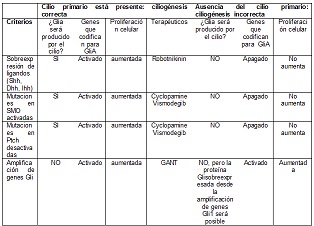El cilio primario y su relación con el cáncer / Primary cilio and its relationship with cancer
Palabras clave:
cilio primario, vía Hedgehog, tumorogénesis, meduloblastoma, carcinoma de células basalesResumen
El cilio primario es un organelo inmóvil localizado en casi todas las células del organismo humano. Es una prolongación filiforme de membrana citoplasmática, formado por un núcleo de nueve dobletes de microtúbulos periféricos, que capta señales mecánicas y químicas para formar una respuesta celular, la que está regulada de una manera coordinada con el ciclo celular, lo que indica su papel en la progresión tumoral. Su participación en la vía de señalización Hedgehog puede promover la proliferación celular y la sobre expresión de la misma puede causar cáncer. Dada la importancia del tema se realizó una revisión de 22 referencias bibliográficas con la finalidad de explicar la relación entre el cilio primario y el desarrollo de algunas variedades de cáncer a través de su estructura-función, destacando la vía de señalización Hedgehog. Abstract The primary cilium is an organelle in mobile localized in almost every cells of the human being. It is a vilifying prolongation of the cytoplasmic membrane, forming by a nucleus of nine doublets of micro peripheral tubules, which capture mechanical and chemical signals to form a cellular response, which is regulated in a coordinated manner with the cell cycle, which indicates its role in the turmeric progression. Its participation in the Hedgehog signaling path can promote cell proliferation and the over expression of it can cause cancer. Given the importance of the subject, a review of 22 bibliographic references was carried out to explain the relation between the primary cylinder and the development of varieties of cancer through its structure-function highlighting the Hedgehog signaling path.Citas
1. Badano JL, Mitsuma N, Beales PL, Katsanis N. The ciliopathies: an emerging class of human genetic disorders. Annu Rev Genomics Hum Genet. 2006;7:125-48.
2. Fliegauf M, Benzing T, Omran H. When cilia go bad: cilia defects and ciliopathies. Nat Rev Mol Cell Biol. 2007;8(11):880-93.
3. Falk N, Losl M, Schroder N, Giessl A. Specialized Cilia in Mammalian Sensory Systems. Cells. 2015;4(3):500-19.
4. Barakat M, Scott M. Tail Wags Dog: Primary Cilia and Tumorigenesis Cancer Cell. 2009;16:276-7.
5. Plotnikova O PE, Golemis E Primary Cilia and the Cell Cycle Methods Cell Biol 2009;94:137-60.
6. Ramírez Z, Zubia D, Gónzalez L. La disfunción del cilio primario y su relación con las ciliopatias. Bases moleculares y celulares. Panorama Cuba y Salud. 2017;12(1):45-52
7. Bloodgood RA. Sensory reception is an attribute of both primary cilia and motile cilia. J Cell Sci. 2010;123(Pt 4):505-9.
8. Gómez AM. Cilio primario y cáncer. Anatomía e Histología Humana [Internet]. 2015; 6º Medicina - TFG. Available from: https://zaguan.unizar.es/record/47944/files/TAZ-TFG-2015-934.pdf
9. Michaud E, Yoder B. The Primary Cilium in Cell Signaling and Cancer Res 2006 66(13):[6463-7 pp.]. Available from: www.cancerres.aacrjournals.org
10. Hassounah N, McDermott K. Molecular Pathways: The Role of Primary Cilia in Cancer Progression and Therapeutics with a Focus on Hedgehog Signaling. Clin Cancer Res [Internet]. 2012; 18(9)(9):[2429–35 pp.]. Available from: www.aacrjournals.org.
11. Sotak B, Gleeson J. Can't get there from here: cilia and hydrocephalus Nature Medicine 2012;18(12):1742-3.
12. Dai D, Zhu H, Wlodarczyk B, Zhang L, Li L, Li A, et al. Fuz controls the morphogenesis and differentiation of hair follicles through the formation of primary cilia. . The Journal of investigative dermatology 2011;131:302-10.
13. Khan NA, Willemarck N, Talebi A, Marchand A, Binda MM, Dehairs J, et al. Identification of drugs that restore primary cilium expression in cancer cells. Oncotarget. 2016.
14. Miyamoto T, Hosoba K, Ochiai H, Royba E, Izumi H, Sakuma T, et al. The Microtubule-Depolymerizing Activity of a Mitotic Kinesin Protein KIF2A Drives Primary Cilia Disassembly Coupled with Cell Proliferation. Cell Rep. 2015.
15. Nobutani K, Shimono Y, Yoshida M, Mizutani K, Minami A, Kono S, et al. Absence of primary cilia in cell cycle-arrested human breast cancer cells. Genes to Cells. 2014;19:141–52.
16. Wong SY, Seol AD, So PL, Ermilov AN, Bichakjian CK, Epstein EH, et al. Primary cilia can both mediate and suppress Hedgehog pathway-dependent tumorigenesis. Nat Med. 2009;15(9):1055-61.
17. Moser J, Fritzler M, Rattner J. Ultrastructural characterization of primary cilia in pathologically characterized human glioblastoma multiforme (GBM) tumors BMC clinical pathology. 2014;14:40.
18. Castresana JS. Cancer as a Ciliopathy: The primary cilium as a new therapeutic target. J Carcinog Mutagene. 2015;6:6.
19. Basten S, Giles R. Functional aspects of primary cilia in signaling, cell cycle and tumorigenesis. Cilia. 2013;2: 6.
20. Han Y, Kim H, Dlugosz A, Ellison D, Gilbertson R, Alvarez-Buylla A. Dual and opposing roles of primary cilia in medulloblastoma development. Nat Med 2009;15:1062–5.
21. Carcinoma de celulas basales. MedlinePlus Enciclopedia medica en español: US National Library of Medicine and National Institutes of Health, USA2007.
22. Sénicourt B, Boudjadi S, Carrier J, Beaulieu JF. Neoexpression of a functional primary cilium in colorectal cancer cells. Cell Biology [Internet]. 2016; 2(5). Available from: http://dx.doi.org/10.1016/j.heliyon.2016.e00109.



